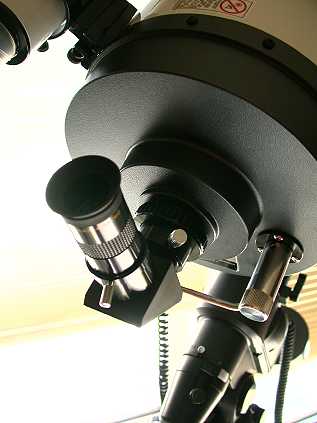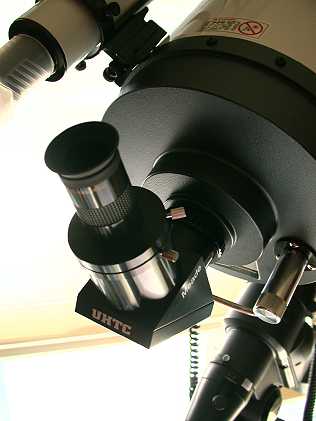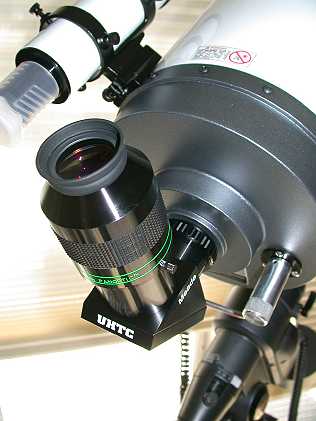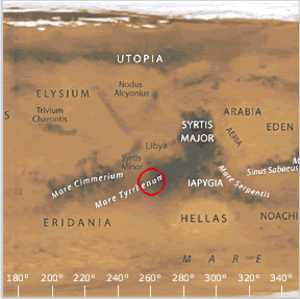
Last updated: 19 October 2003
 |
Last updated: 19 October 2003 |
After over two months of "June Gloom" (in both May and June!) consisting of fog, clouds, and things that conspired to keep me away during those rare times of clear skies, July arrived here in Southern California with warm temperatures and clear skies! I finally had a chance to try out my new TeleVue 2" 35mm Panoptic eyepiece that I purchased from OPT last month. I also got to finally view Mars. Wow, it has been a long two months!
First the 2" TeleVue. Unlike the other LXD55 models, the 8"SC does not come with a 2" star diagonal. Only the 1.25" star diagonal is supplied. Here is a photo of it and the standard 26mm eyepiece:

So I had to also purchase a 2" Meade star diagonal. I got the #929 with UHTC (since the telescope also has UHTC), $120. This diagonal comes with a 1.25" adapter so both size eyepieces can be used. Here you can see the 1.25" 26mm eyepiece inserted:

But it is when I added the TeleVue 2" 35mm Panoptic, $365, that things looked really interesting:

That's one BIG EYEPIECE! But oh, the views! The eyepiece has an apparent field of view of 68 degrees and really displays a lot of sky in crisp details.
My first target for the 2" (57x) was M13, the Great Globular Cluster in Hercules. An amazing number of individual stars were readily visible. Really very beautiful. I then slewed to M57, the Ring Number in Lyra. Also very nice. I replaced the 2" eyepiece with the standard 1.25" 26mm (77x). Got a standard view of M57 with the 8"SC but still very nice. I then looked at M57 with a 1.25" 12.4mm (161x) eyepiece and the Celestron Light Pollution Reduction (LPR) filter. Definite structure was visible in the ring.
Next up was Mizar, the Double Star in the Big Dipper (Ursa Major). Beautiful in the 2" 35mm eyepiece and very bright! I SYNCed the Autostar on Mizar and did a GOTO to M51, the Whirlpool Galaxy. And there it was! This was the first time I've been able to see M51 from my backyard; there is significant Los Angeles light pollution in my northern skies but using the 2" eyepiece, M51 was easily visible. Both bright nucleus areas were visible. I then switched to the 26mm plus LPR; the sky was darkened but M51 was not visible. I tried for M81 and M101 in the 2" but both were lost in the sky brightness.
I then viewed M3, another Globular Cluster, in the 2" 35mm eyepiece. It is more compact than M13 but many individual stars were still visible. Very nice. I then SYNCed on Antares and did a GOTO to M4, a nice cluster. Very beautiful in the 2" 35mm.
I went back to M13 and tried out some additional 1.25" eyepieces: 12.4mm (161x) still showed nicely resolved stars, 9.7mm (206x) also showed resolved stars with nice contrast against a darker sky, and 6.4mm (312x) was a bit too much and was hard to focus on individual stars in the cluster.
I then came inside for about an hour to wait for Mars to rise above the houses (I read some more of Carl Sagan's Contact novel). Finally about 0115 on the morning of 3 July Mars cleared the houses.
I first tried my 1.25" 6.4mm (312x) eyepiece; as Mars was still pretty low in the Southeast there was too much turbulence to use this much magnification. I switched to the 9.7mm (206x); the South Polar Ice Cap and several dark areas, notably Syrtis Major, were easily visible. Mars showed a definite gibbous phase. I then tried all my of filters; the Moon Filter actually did the best job. It reduced the glare (Mars is pretty bright now and getting brighter!) making it easier to view details on the planet. Similar results were achieved when using a Polarizing Filter.
I then went back to M13 and spent many minutes just looking at it and enjoying the view through the 2" 35mm eyepiece. I am definitively going to enjoy using this eyepiece!
I then called it a night, a very successful and wonderful night of observing.
By the way, don't forget to use Sky and Telescope's Mars Profiler to see what visible's for any time.
8 August 2003
Good weather and my schedule finally coincided and so I took the LXD55-8"SC outside for a look at Mars. I set up at 2300 hours. Mars will still low in the Southeast, just rising over a rooftop, and the telescope had not cooled down, but that didn't stop me from looking at Mars first thing. I did a One Star alignment and then a GOTO Mars; the Autostar put it in the finderscope. In the 26mm eyepiece (77X) a dark area was visible. With the 12.4mm eyepiece (161X) the view was not steady enough yet for any good views. So I went to the Moon; with the 12.4mm plus a Moon Filter the view was still "boiling", probably due to the telescope not reaching thermal equilibrium yet. I tried the 6.4mm eyepiece (312X) on the Moon but there was just too much turbulence for effective viewing.
I decided to try for Uranus; I did a GOTO to Mars, SYNCed on it (normally it is not a good idea to SYNC on planets), and then did a GOTO Uranus; the Autostar put it in the 26mm eyepiece field-of-view. In the 12.4mm Uranus was a nice blue dot with a visible disk.
At 2330 I went back to Mars. Things were improving. With the 12.4 plus an Orange Filter (#21) there were obvious dark areas across the disk and the South Polar Ice Cap was very evident. This image from the Sky & Telescope Mars Profiler shows that Syrtis Major and the surrounding area is what I was seeing.

I switched to the 6.4mm and the view was pretty good at times. With the Orange Filter added the "seeing" was actually improved; lots of details were visible. With the 6.4mm plus Moon Filter (to reduce the brightness of Mars) Mars appeared in a nice natural color but there was not much contrast. With the 6.4mm plus a Light Green Filter (#56) I could see some dark areas near the Southern Ice Cap. Using a Light Blue (#82) or Light Yellow (#8) filters did not improve the views over that seen without any filter. I decided that the 6.4mm (312X) plus the Orange Filter provided the best views to this point.
I then used the 6.4mm with a Polarizing Filter. Mars was higher in the sky by now and the telescope had cooled down more so the views were improving. When used in combination with the Orange Filter and by adjusting the polarizing filter I could bring out various details. I noticed what appeared to be some clouds along the North Eastern limb. The 6.4mm plus Orange Filter plus Polarizing Filter gave the best view of everything I tried.
I did push the telescope to beyond its maximum theoretical magnification (400X) by using the 6.4mm plus a 2X Barlow Lens, yielding 625X. Seeing was still not good enough (low altitude probably) to make this really usable but the Ice Cap and Syrtis Major were visible. When I added the Orange Filter the view was better but still not that good.
My conclusion: use the 6.4mm (312X) in combination with the Polarizing and Orange filters. You can read more about these filters on the Accessory Reviews - Filters page on my ETX Site.
18 August 2003
I made a "Hartmann Mask" to aid in focusing, both visually and photographically. You read more about that in the article "Making and Using a "Hartmann Mask" for Focusing". I did some brief Mars observing before trying out some digital camera photography of Mars. Unfortunately, the session was abbreviated due to fog rolling in.
24 August 2003
After last night's heavy dew-ing, tonight was much drier. I set up about midnight and decided to wait for the telescope to cool-down before taking any Mars photos. But that didn't stop me from doing some observing of other objects. First up was M57, the Ring Nebula in Lyra. It was really nice in the 15mm eyepiece (133X). I switched to the TeleVue 32mm Panoptic 2" eyepiece (62X); wow! Using averted vision I could detect what appeared to be the central star!
Then I went to checkout Mars. Using the 26mm eyepiece plus the Meade Variable Polarizing Filter the glare of Mars was reduced but cool-down was not yet sufficient to see any details other than the South Polar Ice Cap. A little later I switched to the 12.4mm (161X) with the polarizing filter; by adjusting the filter I could bring out more details by reducing the glare. Some clouds were starting to appear in our sky so I began to get nervous! I then tried the 6.4mm (312X) and filter; the view wasn't that bad but it was obvious the telescope had not yet cooled down enough for that magnification. So backed up somewhat by using the 9.7mm (206X) and filter; this was actually the best view of Mars so far tonight.
Since the telescope needed some more cool-down time I decided to look at M31, the Great Galaxy in Andromeda. The view in the 26mm eyepiece was nice but in the 2" 32mm Panoptic a lot more of the galaxy was visible. It still appeared fuzzy of course; no distinct structure was visible.
OK, time to go back to Mars since those clouds in our atmosphere persisted.
My intention tonight, besides just looking at Mars, was to take several photographs that I could stack using Keith's Imager Stacker. I used my homemade Hartmann Mask for focusing but removed it for the actual photos. You can so the results on My LXD55 Astrophotography - Planets page.
29 August 2003
On the night of 29 August 2003 (a few days after the closest approach), I went out to observe Mars. As midnight approached Mars was getting near to its highest point in my sky so the seeing was pretty good. I first set up my LXD55-8"SC. While waiting for the 8" to "cool down" I brought out my ETX-70AT and ETX-90RA telescopes to see how Mars looked at this close approach through them. You can read my report with those telescopes on my ETX Site). That report should help others who wonder if they can see Mars in those (and similar) small telescopes.
Keep in mind that Mars is now getting further from the Earth and so will be getting smaller in apparent size. But for the next several weeks it will still make a fine object to view.
Once I finished observing with the ETX-70 and ETX-90 I went back to the LXD55-8"SC. I used the 12.4mm, 9.7mm and 6.4mm eyepieces that came with the Meade $99 eyepiece deal. I also used a Scopetronix Moon Filter and a Meade #126 2X Barlow Lens. I recommend investing in a Moon Filter if you plan to view the Moon; the filter reduces the brightness of the Moon, making it less painful to view it, especially near Full Moon. A Barlow Lens is also a useful addition if you have a limited set of eyepieces. So, I decided to test with these since I hope that many users have these accessories. I also used a Meade Variable Polarizing Filter.
12.4mm (161X) - Bright! Hard to see details although the South Polar Ice Cap was visible.
12.4mm + Polarizing Filter (161X) - The filter reduced the glare, making it easy to see a large dark area and the Ice Cap.
6.4mm + Polarizing Filter (312X) - Still pretty good. Shape of the dark area was easily visible as well as the Ice Cap.
6.4mm + 2X Barlow Lens + Polarizing Filter (625X) - Only the Ice Cap was visible. You notice that I have now exceeded the max theoretical magnification for the 8" (400X). Mars was bright enough (right now) to make this possible but the view wasn't very good.
9.7mm + Moon Filter (206X) - I had inadvertantly left the Moon Filter attached to the 9.7mm following my ETX observations and didn't discover this until after I had already come back inside for the night. But even with the filter, Mars was still too bright in the 8" to be easily looked at.
9.7mm + Moon Filter + Polarizing Filter (206X) - Adding the Polarizing Filter really helped to reduce the glare and bring out the dark areas and Ice Cap. By adjusting the filter position I could enhance the view of the dark areas.
9.7mm + Moon Filter + 2X Barlow Lens (412X) - I exceeded the max magnification (slightly) but some dark areas were still visible. However Mars was still too bright (at Magnitude -2.9) to make out any good details.
9.7mm + Moon Filter + 2X Barlow Lens + Polarizing Filter (412X) - During moments of good seeing, this was actually a pretty nice view of Mars. The only downside was that the image was really too dim for any good details to be seen.
Bottom line: the 9.7mm + Moon Filter + Polarizing Filter (206X) provided the best view of Mars, clearly showing the most details.
19 October 2003
Had a house party yesterday. Since it started in the afternoon and since it was clear I set up my ETX-90RA with a solar filter and showed our guests the Sun. There were only a couple of small sunspots visible though. Just before sunset I swapped the ETX-90 for the LXD55-8"SC to show Venus before it set.
Since the sky was still bright I set the telescope up in approximately the correct Home position; obviously I couldn't see Polaris but I've set up in the same location numerous times so I had a pretty good idea of True North. I then did an Easy 2 Star Align and just accepted the stars as centered when the slewing stopped. I apparently guessed pretty good as Venus was visible near the edge of the finderscope! (The sky was still too bright to allow Venus to be seen with the naked eye.) I centered it and showed the guests a nice round white disk. No phase was visible but they enjoyed it anyway.
Later, Mars had cleared a house and several people got to enjoy seeing Mars. Lots of details were visible even though since August we are fast leaving Mars behind in its orbit. Everyone really liked the view.
As darkness continued, the guests who remained were treated to several open and globular star clusters, nebulae, and the Great Andromeda Galaxy using my 2" TeleVue 35mm Panoptic eyepiece. Most were excited with the views. A couple of times I had to explain the difference between Hubble Telescope images and viewing with the eye.
Now, about that initial guess on the Home position. Throughout the 3.5 hours of using the LXD55 I never redid my setup. Tracking of Mars continued to keep it within the 12.4mm eyepiece FOV for 30+ minutes. I did SYNC on Vega once. GOTOs worked well for objects within about 30 degrees of Vega; they appeared within the FOV of the Panoptic. M31 was outside the eyepiece but in the finderscope.
Morals of this story: Know your location and don't be afraid to setup before dark. Don't be afraid to use SYNC (don't use planets for SYNC) to improve the alignment when observing objects over a large expanse of the sky; just pick a centrally located object for the area of the sky containing the objects you plan to GOTO. And show your love of the night sky to your guests!
Return to the top of this page.
November, December 2002 and January 2003 observations
Go to back to my LXD55 Home Page.
Go to Weasner's Mighty ETX Site.